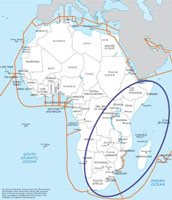Making an international phone call or connecting to high-speed internet is beyond the reach of the average citizen of East and Southern African countries* in part because the region is not connected to the global optical fiber broadband infrastructure. The ‘missing link’ explains why the region accounts for less than one percent of the world’s international bandwidth capacity.
Prohibitive Cost of International Connectivity
Twenty countries of the region lack direct terrestrial access to global information and communications infrastructure and networks and are forced to rely on expensive satellite connectivity to link up with each other and the rest of the world.
This translates into some of the highest communications costs in the world. International wholesale bandwidth prices are 20 to 40 times higher than in the United States, and international calls are on average 10 to 20 times more than in other developing countries.
Holding Back Africa's Progress
The region’s growth and development is being held back by this lack of access to low price and high quality telecommunications services. Furthermore, it impedes regional and international trade and limits the extent of job creation. The limited and costly access also hinders the potential to utilize information and communication technologies to extend learning, promote social participation and improve government efficiency and transparency.
The Africa Regional Communications Infrastructure Program – RCIP
The Africa Regional Communications Infrastructure Program (RCIP) aims to address this ‘missing link’ and to improve access to international connectivity by focusing on closing the terrestrial connectivity gap.
Connectivity and transparency are the two over-arching development objectives of RCIP. The Program will extend the geographic reach of broadband networks and contribute to lower prices for international capacity, while contributing to improved Government efficiency and transparency through selected e-government applications.
Kenya, Burundi and Madagascar are involved in the first phase of RCIP which has a combined volume of US$164.5 million, out of the US$424 million envelope for the overall program. Other eligible countries in East and Southern Africa can join future phases of the Program on a readiness basis.
RCIP is an innovative example of the emphasis on regional integration, which accounts for more than 10% of total World Bank support to Africa.
By the end of the Program, it is expected that all capitals and major cities in East and Southern Africa would be linked to competitively priced high-bandwidth connectivity. Lower prices for international connectivity will decrease the cost of doing business and significantly improve private sector investment opportunities in the region. Universities, schools and hospitals benefit; and governments will be able to deliver services to citizens more efficiently and transparently online.
*East and Southern Africa (E&SA) is defined as the following 25 countries: Angola, Botswana, Burundi, Comoros, Democratic Republic of Congo, Djibouti, Eritrea, Ethiopia, Kenya, Lesotho, Madagascar, Malawi, Mauritius, Mozambique, Namibia, Rwanda, Seychelles, Somalia, South Africa, Sudan, Swaziland, Tanzania, Uganda, Zambia, and Zimbabwe.
Related article: https://www.bizcommunity.com/Article/410/16/14114.html
Article by courtesy of the World Bank










































